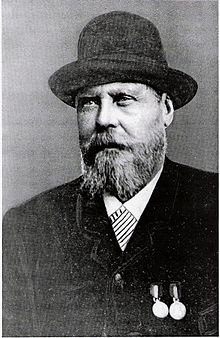Peeter All
| Peeter All | |
|---|---|

Peeter All in 1880
|
|
| Born | 1829 |
| Died | 1898 (aged 69) |
| Occupation | Estonian fisherman, farmer, ship captain, shipowner, and rescuer of mariners |
Peeter All (1829–1898) was an Estonian fisherman, farmer, ship captain, shipowner, rescuer of mariners in distress and a salvage diver who became one of the wealthiest Estonians of his time.
Peter's parents, Ado and Marie, were peasants who lived on Saaremaa's Loona Manor. Saaremaa (known as Oesel in German), is Estonia's largest island (2,673 km2) and has numerous small, rocky, low-lying islands off its western coast. The largest of these is called Vilsandi. When Peter was a year old, Baron Hoyningen-Huene sent the family to live on Loonalaid, a small (1 km2.) uninhabited Baltic Sea island, so his father could look after the hay grown there that provided feed for the manor's livestock. The family survived primarily from fishing and farming. Peter grew up to be a large man (210 cm tall) and left home by 20 years of age to become a seaman. During the Crimean War (1853–1856) Peter tried to run the Baltic Sea blockade with a cargo of salt from Sweden and his ship was seized. He was arrested by the British, his ship was burnt and he was jailed for 3 years.
After being released from jail, Peter returned to Loonalaid and decided to plant potatoes not in the island’s rocky soil but in the near-shore kelp beds. He found that these potatoes ripened much faster than conventionally planted ones because the sun's rays heated the shallow waters. Demand for these early season potatoes was strong and they commanded a premium price at market in Riga, Latvia, more than 100 km by sea. Peter eventually bought Loonalaid from the Baron, and employed about a half-dozen farmhands who, when not working in the fields or with the small number of cows and many sheep, helped with the salvaging operations.
With his profits from selling potatoes Peter bought a diving helmet from Germany and began to salvage the numerous ships lying on the ocean floor that had been wrecked on the nearby shoals. It was rare for ships in the Baltic to carry precious cargo and All primarily salvaged coal, metals and antique porcelain, the sale of which helped him to move in social circles far above his standing. Peter All found that upper classes in St. Petersburg, Russia were prepared to pay handsomely for porcelain that was over one hundred years old and he did very well for himself, becoming one of the wealthiest Estonians of the time. In 1880 he was the first Estonian to have his photograph taken, a colored ferrotype that is on display at the Estonian Maritime Museum in Tallinn.
...
Wikipedia
